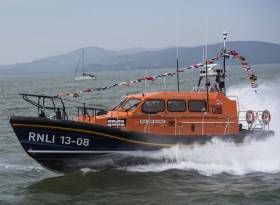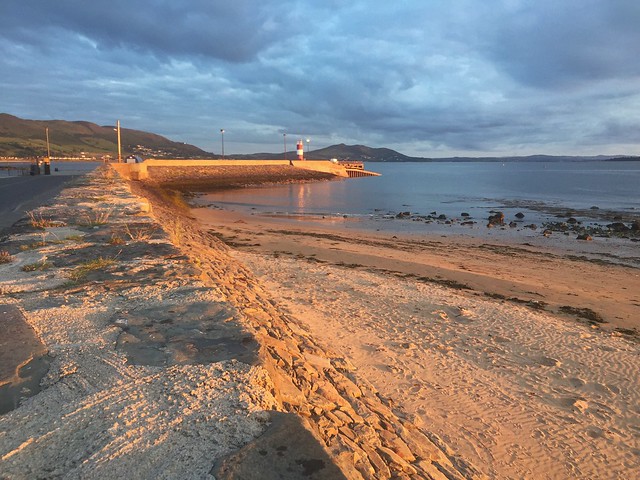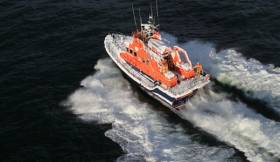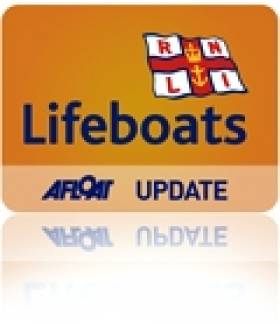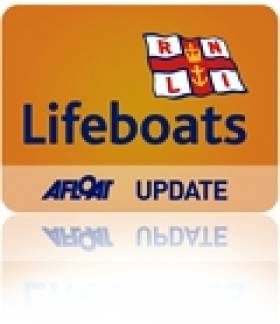Displaying items by tag: Lough Swilly
Lough Swilly RNLI Officially Name New Shannon Class Lifeboat 'Derek Bullivant' in Buncrana, Donegal
The first Shannon class RNLI lifeboat to go on service in Ireland was officially named today in a special ceremony attended by crowds of people in Buncrana, county Donegal. The €2.4m life-saving vessel has already been on nineteen callouts since its arrival on the North-West Coast last year and today it was officially named the ‘Derek Bullivant’ by the man responsible for getting the RNLI’s latest class of lifeboat named after an Irish river.
Arklow man Jimmy Tyrrell was with the RNLI for 46 years, making him the charity’s longest serving lifeboat operations volunteer on his retirement. He campaigned to have the RNLI name a class of lifeboat after an Irish river, in recognition of the service and dedication of Irish lifeboat volunteers. His wish was finally realised with the design and manufacture of the Shannon class lifeboat. The first of the class went on service at Dungeness in Kent back in 2014 .Jimmy was asked by Lough Swilly RNLI to officially name the lifeboat and he did so through the time honoured tradition of pouring champagne over the bow of the lifeboat to cheers from the crowd.
It was an emotional day for Jimmy, whose family are well-known and respected boat builders, as it is the culmination of a 27-year campaign to name an Irish lifeboat class. Speaking at the ceremony he said, ‘During my lifeboat career I have seen many changes in lifeboats, from wood, to steel, to fibre-glass and to today’s composite construction. Lifeboat speeds varied from eight-knots going downhill with the wind up your transom to this wonderful new waterjet propulsion achieving 25-knots. However, one thing that has not changed in the RNLI and that is its people. The basic commitment of crews is the same. Generations of them have put their lives on the line and sometimes lost their lives trying to help those in peril on the seas.’
A small service of blessing followed led by Fr Francis Bradley, Parish Priest of Buncrana and Reverend Judi McGaffin, Church of Ireland Rector.
The Donegal lifeboat station was the first in Ireland to receive the new lifeboat, which is the most modern and technically advanced lifeboat in the RNLI fleet. The Shannon is first class of lifeboat to be propelled by waterjets instead of traditional propellers, making it the most agile and manoeuvrable all-weather lifeboat in the fleet. The lifeboat has a top speed of 25 knots and a range of 250 nautical miles. The lifeboat was developed to operate in the worst of sea conditions and is self-righting, automatically turning the right side up in the event of a capsize.
The Derek Bullivant lifeboat (ON 1315) was funded by legacies from Mr Derek Bullivant and Mrs Valerie Walker. Mr. Bullivant was born in Birmingham in 1922 and went on to establish one of the biggest aluminium recycling companies in the UK. He wanted his success to benefit lifesaving and humanitarian charities which led him to provide a generous legacy which helped to fund the Lough Swilly lifeboat. The second legacy was bequeathed from Mrs. Valerie Walker from Portsmouth. Mrs. Walker was a supporter of the RNLI and her legacy has been used to part fund the lifeboat. A plaque honouring her will be placed in the lifeboat station.
Accepting the lifeboat, Lough Swilly RNLI Lifeboat Operations Manager John McCarter said, ‘While we are in celebratory mood today God knows we have seen and been closely involved in our share of tragedy around our community, and we remember all those who have suffered great loss at the mercy of the sea. However at Lough Swilly RNLI it also strengthens our resolve to work harder and keep our equipment state of the art to enable us to provide search and rescue service around our coast. The Derek Bullivant lifeboat is testament to that.’
‘There are thirty volunteers at Lough Swilly RNLI. A number of our crew have been here from the beginning as young boys and girls and matured with the station where they now have families and potential new volunteers coming on themselves. Today is a very proud day for all of us here at Lough Swilly RNLI and I am absolutely delighted on behalf of all at Lough Swilly to accept this new Shannon Class boat the RNLB Derek Bullivant into our care.’
In the 29 years since Lough Swilly RNLI was established they have launched 741 times, brought 568 people to safety and saved forty-nine lives.
#RNLI - Arklow man and former lifeboat operations manager Jimmy Tyrrell will have the honour of naming the first class of RNLI lifeboat to be named after an Irish river this Saturday 25 June in Buncrana, Co Donegal.
Lough Swilly RNLI will hold the special naming ceremony and service of dedication from 11.30am to officially name the first Shannon-class lifeboat in Ireland, Derek Bullivant.
The Donegal lifeboat station was the first in Ireland to receive the new €2.4 million lifeboat, which is the most modern and technically advanced lifeboat in the RNLI fleet.
Shortly after its arrival on station, the lifeboat brought three local fishermen to safety after they had been reported missing when their vessel had lost power and drifted out to sea.
The lifeboat was funded by legacies from Derek Bullivant and Valerie Walker. Bullivant was born in Birmingham in 1922 and was a trained chemist before working as an industrial analyst for a company in the metal industry. He went on to start his own company which became one of the biggest aluminium recycling companies in the UK. He always wanted his success to benefit lifesaving and humanitarian charities which led him to provide a generous legacy which helped to fund the Lough Swilly lifeboat.
The second legacy was bequeathed from Valerie Walker from Portsmouth. Walker was a supporter of the RNLI and her legacy has been used to part fund the lifeboat. Her generosity will be remembered and acknowledged by a plaque which will be placed in the boathouse at Lough Swilly lifeboat station.
The Shannon is first class of lifeboat to be propelled by water jets instead of traditional propellers, making it the most agile and manoeuvrable all-weather lifeboat in the fleet.
Waterjets allow the vessel to operate in shallow waters and be intentionally beached. The lifeboat has a top speed of 25 knots and a range of 250 nautical miles, which makes it ideal for offshore searches and rescues in calm and rough seas.
The new lifeboat was developed to operate in the worst of sea conditions and is self-righting, automatically turning the right side up in the event of a capsize. Its unique hull is designed to minimise slamming of the boat in heavy seas and the shock-absorbing seats further protect the crew from impact when powering through the waves.
Commenting on the forthcoming occasion, Lough Swilly RNLI lifeboat operations manager John McCarter said: "Many people will know that we welcomed the lifeboat to Buncrana a little over a year ago but in grand RNLI tradition we officially name and dedicate the lifeboat after that and in doing so remember our generous benefactors who through their legacies have provided this incredible gift to our community.
"We are delighted that Jimmy Tyrrell will be officially naming our lifeboat. Our colleagues in the lifeboat community will know that Jimmy lobbied the RNLI for years to have a class of lifeboat named in recognition of the role Ireland and Irish lifeboat volunteers have played in the work of the charity for 192 years. All other lifeboat classes are named after UK rivers so the Shannon is truly an Irish lifeboat."
The Shannon lifeboat also has another strong Irish connection. Peter Eyre, an RNLI engineer from Derry who works at the charity’s headquarters in Poole, was instrumental in the development of the new lifeboat, designing the hull form at the age of 24.
The first all-weather lifeboat put on service in Lough Swilly was The Good Shepard in 2000.
Five Dead After Family Car Plunges Off Donegal Pier
#Buncrana - Five people, including three children, understood to be from the same family are dead after their car slipped into the water at Buncrana, Co Donegal last night (Sunday 20 March).
As the News Letter reports, a major emergency operation was launched after the Northern Ireland-registered estate car went off a pier into Lough Swilly after 7pm.
The bodies of two adults and three primary-aged children were recovered shortly after.
A baby who was also in the car is believed to have been thrown or handed out of the vehicle before it went into the water.
The cause of the tragedy is not yet known but it's understood that the surface of the pier slipway may have been slippery with algae.
The News Letter has more on the story HERE.
#RNLI - Portrush RNLI had a busy 24 hours earlier this week with two early morning callouts on consecutive days.
The volunteer lifeboat crew was alerted at 4.45am on Monday (14 March) to reports of a fishing vessel that had lost power two miles off the coast of Ballycastle.
However, as the all-weather lifeboat approached Ballycastle the crew was stood down as another vessel had responded and assisted the vessel to get underway.
The crew was requested to launch once again went at 12.30am yesterday morning (Tuesday 15 March) to reports of a 23m fishing vessel 12 miles northwest of Portrush that had got nets caught around its propeller.
The weather was cold but calm and the Portrush lifeboat crew were joined by their lifeboat colleagues from Lough Swilly RNLI and their new Shannon class lifeboat, The Derek Bullivant.
The Portrush crew attached a towline to the fishing vessel and towed her into Greencastle Harbour under the guidance of Lough Swilly RNLI
The Portrush crew had last seen the Shannon when she and her crew made Portrush their last call when returning from Poole to Buncrana in April last year.
Speaking following the callout, Portrush RNLI lifeboat operations manager Robin Cardwell said: "This was a tow for which both crews are trained and executed perfectly.
"The Portrush crew towed the vessel into Greencastle and aworked well with our flank station Lough Swilly who helped us into harbour."
#lifeboat – In the early hours of this morning Lough Swilly RNLI rescued three fishermen who had been reported missing after they failed to return home. It was the first rescue for Lough Swilly RNLI's new Shannon class lifeboat and her volunteer crew.
The callout occurred after the three fishermen from the Malin area took out a small fishing boat to test the engine just after 7.30pm last night. The alarm was raised before midnight when they had not returned and had failed to make contact with anyone on shore.
In a major search operation Malin Head Coast Guard requested Lough Swilly RNLI to launch both the Shannon class lifeboat and the inshore Atlantic lifeboat, along with the Portrush RNLI all-weather lifeboat and the Greencastle Coast Guard shore based unit. The groups were also joined by a large contingent of local fishing vessels from the Malin and Glengad area.
Conditions were described as choppy when at 2.30am the missing fishermen managed to make a call and give an approximate location. Lough Swilly RNLI's Shannon class lifeboat then picked up a small spot on their radar and headed for the area with large searchlights trained on the water. They located the men safe and well and wearing survival suits and lifejackets. The vessel has lost power and had drifted 12 miles.
Commenting on the callout John McCarter Lough Swilly RNLI Lifeboat Operations Manager said, 'You fear the worst when you hear fishermen are missing and we have seen too many tragedies in this part of the world. However the men kept their heads and were in proper survival gear which gave them every chance if something happened. The outpouring of support from the local fishing community was wonderful and bringing the vessel home under tow behind the lifeboat, to be greeted by locals lining the pier at that early hour of the morning was an incredible sight.
In this first rescue for our new Shannon class lifeboat, the time it took for us to reach the search area has been reduced on what our previous lifeboat could achieve, which in search and rescue operations can mean the difference between a life saved or a life lost.'
First RNLI Shannon Class Lifeboat in Ireland to Arrive into Lough Swilly, County Donegal
#rnli – Lifeboat crew from Lough Swilly RNLI are currently onboard the station's new €2.4 million Shannon class lifeboat and en route to its permanent home in Donegal from the charity's headquarters in Poole. As Afloat reported earlier, he new lifeboat is the first of its class to be put on service in Ireland and the first to be named after an Irish river, the previous classes are all called after UK rivers.
The lifeboat crew are being accompanied on the journey by RNLI staff coxswain Martin Philips, who is using the long passage home as an opportunity to continue with the training programme for the state of the art lifeboat. On the last leg of the passage the crew will be joined by RNLI Divisional Operations Manager Darren Byers but the honour of taking the lifeboat into Lough Swilly will fall to the station Coxswain, Mark Barnett. The crew got a preview of the boat in build last November.
The station is hoping for a large turnout at the Buncrana pier as the new lifeboat arrives into the harbour at noon on Friday 10 April, to take up residence on the Donegal coastline. The lifeboat is named Derek Bullivant and has been largely funded through a legacy from Mr Bullivant who hailed from Bewdley, Worcestershire, UK and who passed away in September 2011.
The Shannon is the latest class of all-weather lifeboat to join the RNLI fleet and the first to be propelled by waterjets instead of traditional propellers, making it the most agile and manoeuvrable all-weather lifeboat in the fleet. Waterjets allow the vessel to operate in shallow waters and be intentionally beached.
The new lifeboat was developed to operate in the worst of sea conditions and is self-righting, automatically turning the right side up in the event of a capsize. Its unique hull is designed to minimise slamming of the boat in heavy seas and the shock-absorbing seats further protect the crew from impact when powering through the waves. The lifeboat has a top speed of 25 knots and a range of 250 nautical miles, which makes it ideal for offshore searches and rescues in calm and rough seas.
Commenting from onboard the Shannon lifeboat, Lough Swilly RNLI Coxswain Mark Barnett said, 'This day has been a long time coming for our lifeboat station and it is one that is very emotional for all of us. The arrival of a new lifeboat is a huge investment in the community by the RNLI. It's not just a financial investment but it is also an investment in our lifeboat crew, the people who live here and the people who use the waters around our station, whether locally based or just passing through.
This will be its home for many years to come and it will be launched on countless rescues and save many lives. We would also like to express our gratitude to the late Mr Derek Bullivant, whose name is proudly displayed on our lifeboat and whose generosity made this possible.'
Once the lifeboat is on station, training will continue for the remaining volunteer lifeboat crew at Lough Swilly RNLI before the lifeboat is officially put on service and the previous one is retired into the relief fleet.
#rnli – Final preparations are being put in place for 'the Homecoming', which will see Lough Swilly RNLI receive the first Shannon class lifeboat in Ireland. The station is planning a special celebration, as the €2.4 million lifeboat arrives into Lough Swilly harbour at 12 noon on Friday 10 April, to take up residence on the Donegal coastline. The Shannon class is the first lifeboat in the history of the 191 year old lifesaving charity that has been named after an Irish river, in recognition of the service and dedication of Irish lifeboat crews.
The new lifeboat will be named Derek Bullivant and has been largely funded through a legacy from Mr Derek Jim Bullivant who hailed from Bewdley, Worcestershire, UK and who passed away in September 2011.
The coxswains and mechanics from Lough Swilly RNLI have been busy training on the new lifeboat and have travelled over to Poole to familiarise themselves on it. When it arrives to its new home and before it is put on service the volunteer lifeboat crew will be receiving intensive training on site before it is declared operational and put on service.
The Shannon is the latest class of all-weather lifeboat to join the RNLI fleet and the first to be propelled by waterjets instead of traditional propellers, making it the most agile and manoeuvrable all-weather lifeboat in the fleet. Waterjets allow the vessel to operate in shallow waters and be intentionally beached.
The new lifeboat was developed to operate in the worst of sea conditions and is self-righting, automatically turning the right side up in the event of a capsize. Its unique hull is designed to minimise slamming of the boat in heavy seas and the shock-absorbing seats further protect the crew from impact when powering through the waves. The lifeboat has a top speed of 25 knots and a range of 250 nautical miles, which makes it ideal for offshore searches and rescues in calm and rough seas.
The Shannon lifeboat also has another strong Irish connection. Peter Eyre, an RNLI Engineer from Derry who works at the charity's headquarters in Poole, was instrumental in the development of the new lifeboat, designing the hull form at the age of 24. He studied at Foyle College before studying Ship Science at the University of Southampton and undertaking a work placement with the RNLI.
Peter will be travelling over to Inishowen for the homecoming with his new wife Alice and hopes to be onboard the Shannon as it powers into Lough Swilly on the 10 April. Speaking about the new lifeboat Peter said, 'It's fair to say that of all the Shannon lifeboats, Lough Swilly's station boat has a special place in my heart. It was during my youth, which I spent messing around on all types of boats on the Swilly, that I learned one of the most valuable lessons regarding the power of the sea and how quickly conditions can change.
When I was designing the Shannon I had the vast range of conditions found in and around Lough Swilly at the forefront of my mind. If the Shannon could perform in those conditions I would be happy; today as we roll out the Shannon class lifeboats, I'm more than happy.'
Speaking ahead of the event Lough Swilly RNLI Lifeboat Operations Manager John McCarter added, 'Everyone is welcome to come along and see our new lifeboat coming home. We are very proud of the honour that has been bestowed on us and we have been preparing the homecoming for quite some time. Everything that we do is made possible through the great support we receive around the coast and we are very grateful for it.
A new lifeboat at a station is an occasion for celebration and joy but we never forget that during its lifetime it will bring home many loved ones and launch countless times to search, rescue and train. We hope that before that happens that people will come and see the new arrival.'
Lough Swilly RNLI Gets Preview Of New Shannon-Class Lifeboat
#RNLI - Three members of Lough Swilly RNLI recently made a very special trip to check on the progress of the station’s new state-of-the-art Shannon-class lifeboat.
The group visited Lymington in England, where the finishing touches are being put to their new €2.4 million lifeboat in time for its arrival into Inishowen next year.
Lough Swilly lifeboat operations manager John McCarter, coxswain Mark Barnett and mechanic Gregory McDaid were invited by the RNLI to see their new Shannon under construction via a full guided tour by RNLI fleet staff coxswain Martin Phillips.
The new all-weather lifeboat was at the ‘topping out’ stage, where the superstructure was about to be joined with the hull and the lifeboat would then take on the shape that the public recognise today.
All systems in the hull were fitted out and the lifeboat had just received its first distinctive coat of the orange paint that is present on all lifeboats.
Commenting on the visit, McCarter said: "It was incredible to see our lifeboat taking shape in the boatyard. It was completely exposed and you could see up close the minute detail that goes into every single part of the lifeboat.
"In just a few short months that lifeboat will be steaming into the Inishowen peninsula to take up residence here and give support and assistance to many people over its lifetime."
Barnett added: "This is a very special occasion in the life of our station and I am delighted with how our new lifeboat is coming along. We were shown around the boatyard and saw the Shannon-class lifeboats that were being built for other stations in the RNLI.
"However, ours will be the first to go on service in Ireland and for that reason it is extra special.
"I was standing in the bare wheelhouse of our new lifeboat, knowing that soon it would be fitted out with the equipment and seats that will give our volunteer lifeboat crew the tools they need to carry out their roles in all weathers off our coastline."
Adding to the praise for the new lifeboat, Gregory McDaid said: "I have a different view point from the other crew. My role is to make sure that the lifeboat can safely bring the lifeboat crew out in all weathers at any hour, handle anything that is thrown at it and of course bring everyone home safely. With this in mind I was very keen to see the engines on the other Shannons that were in their final stages of construction.
"This lifeboat is the first modern generation all weather lifeboat to run on water jets rather than propellers. This allows the vessel to operate in shallow waters and to be intentionally beached. The two 650hp engines help the lifeboat achieve 25 knots and each one has its own 1,370 litre fuel tank. That engine room will be my new home soon."
Excitement has been mounting locally since the RNLI announced in September that the Lough Swilly lifeboat station in Buncrana, Co Donegal was to be the first in Ireland to receive the new Shannon class lifeboat.
The Shannon is the first class of lifeboat to be named after an Irish river, recognition by the charity of the role of Irish lifeboat crews and volunteers throughout the 190 year history of the RNLI.
The new lifeboat is on course to arrive into Buncrana next April with a vigorous training schedule for the lifeboat crew to commence in January.
Lough Swilly RNLI Lifeboat Rescue Six Men from Sinking Fishing Vessel
#rnli – Lough Swilly RNLI has rescued six men from a sinking fishing vessel off the Donegal coast in the early hours of this morning (Monday 8 September).
The volunteer lifeboat crew was requested to launch both their inshore and all-weather lifeboats at 3.15am at the request of Malin Head Coast Guard.
It followed a report that a fishing vessel with six men on board was taking on water two miles north of Dunree Head. The Irish Coast Guard helicopter Rescue 118 from Sligo was also requested. A local fishing boat which was in the area was also ready to offer assistance.
Weather conditions at the time were described as good with a flat calm sea.
Both lifeboats proceeded in the darkness to the scene where upon arrival they spotted a fishing vessel which was lifting badly and rapidly taking on water.
All six crew on the stricken vessel were wearing lifejackets and survival suits and they had prepared their life raft for deployment.
Three RNLI crew from the all-weather lifeboat were transferred to the vessel. Using a salvage pump they started to pump water from the boat and continued for over an hour.
Once the boat was stabilised, the lifeboat escorted the vessel safely back to shore at Rathmullun where it arrived at seven o'clock this morning.
Following the four hour operation, Mark Barnett, Lough Swilly RNLI Coxswain said: 'The six fishermen deserve to be commended for their quick actions in the early hours of this morning. They called for help once they got into difficultly and had their life raft ready if needed in an emergency. The boat had taken on a considerable amount of water but thankfully our crew was able to assist and avoid the vessel from sinking and assist the men safely back to shore.'
Lough Swilly RNLI Aids Fishermen Near Malin Head
#RNLI - Lough Swilly RNLI came to the aid of two fishermen yesterday (22 August) after their open boat was grounded on rocks near Malin Head, as the Irish Independent reports.
The Lough Swilly lifeboat was joined by the volunteer crew from Greencastle and the Sligo-based Irish Coast Guard rescue helicopter to attend the 22ft fishing boat. Both fishermen on board were recovered and are well.
It is not yet clear how the vessel came to crash on the rocks off Trawbrega Bay, with conditions in the area said to be "not bad". The Irish Independent has more on the story HERE.



























